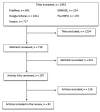Radiation-Induced Cerebro-Ophthalmic Effects in Humans
- PMID: 32316206
- PMCID: PMC7235763
- DOI: 10.3390/life10040041
Radiation-Induced Cerebro-Ophthalmic Effects in Humans
Abstract
Exposure to ionizing radiation (IR) could affect the human brain and eyes leading to both cognitive and visual impairments. The aim of this paper was to review and analyze the current literature, and to comment on the ensuing findings in the light of our personal contributions in this field. The review was carried out according to the PRISMA guidelines by searching PubMed, Scopus, Embase, PsycINFO and Google Scholar English papers published from January 2000 to January 2020. The results showed that prenatally or childhood-exposed individuals are a particular target group with a higher risk for possible radiation effects and neurodegenerative diseases. In adulthood and medical/interventional radiologists, the most frequent IR-induced ophthalmic effects include cataracts, glaucoma, optic neuropathy, retinopathy and angiopathy, sometimes associated with specific neurocognitive deficits. According to available information that eye alterations may induce or may be associated with brain dysfunctions and vice versa, we propose to label this relationship "eye-brain axis", as well as to deepen the diagnosis of eye pathologies as early and easily obtainable markers of possible low dose IR-induced brain damage.
Keywords: angiopathy; brain; glaucoma; ionizing radiation; neurocognitive deficits; optic neuropathy; retinopathy.
Conflict of interest statement
the authors declare no conflicts of interest.
Figures




References
-
- Stewart F.A., Akleyev A.V., Hauer-Jensen M., Hendry J.H., Kleiman N.J., Macvittie T.J., Aleman B.M., Edgar A.B., Mabuchi K., Muirhead C.R., et al. ICRP publication 118: ICRP statement on tissue reactions and early and late effects of radiation in normal tissues and organs—Threshold doses for tissue reactions in a radiation protection context. Ann. ICRP. 2012;41:1–322. doi: 10.1016/j.icrp.2012.02.001. - DOI - PubMed
Publication types
LinkOut - more resources
Full Text Sources

